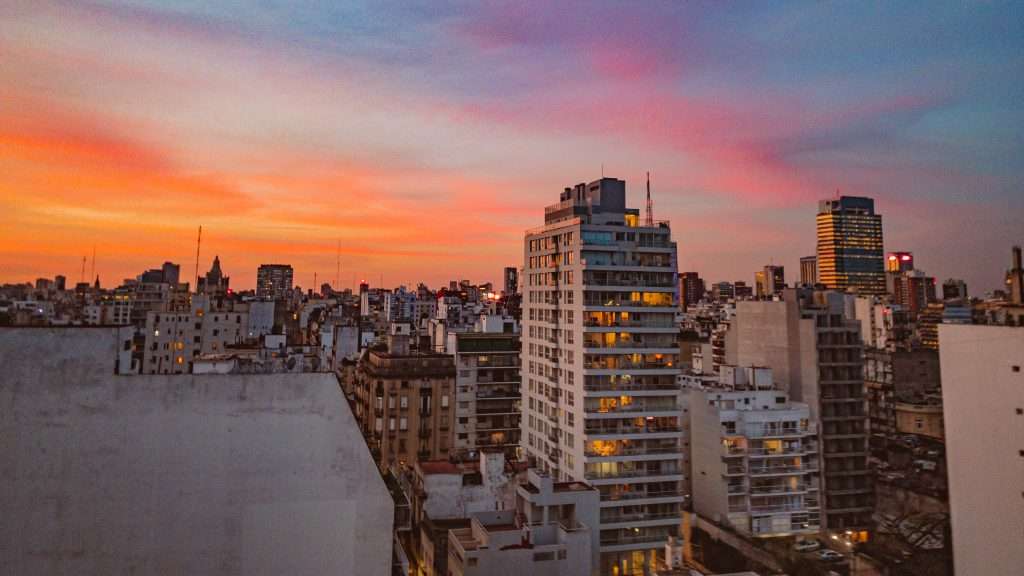Santiago de Chile vs. Buenos Aires: how do they stack up?

I’ve spent a fair amount of time between these two megacity capitals of the southern cone of South America, so I thought it might be fun to compare and contrast them. Very often people speak of Latin America as a monolith, when this couldn’t be further from the truth. There are big differences in terms of development and culture, even within each country, let alone between different countries. Before we start, I just want to make it clear that I am very fond of both Santiago and Buenos Aires – that’s why I keep coming back! This isn’t about declaring one placed definitively better than the other. Variety is the spice of life, and I appreciate each city for what it does well.
People and population
The greater Santiago metro area has around 7 million people, while Buenos Aires metro population is around 15 million. They are both massive metropolises, but Buenos Aires still manages to dwarf Santiago.
While these are obviously both Latin American cities with a large proportion of people of Spanish or mestizo descent, the demographics are slightly different. Both cities attracted large waves of immigration primarily from other Latin and European countries; however, in Buenos Aires there is a very noticeable Italian influence, which lends itself to a more European vibe overall.
My personal observation is that Chileans tend to be a bit less extroverted than Argentinians and a bit more individualistic. There is a stereotype (at least from what I have read on online forums like Reddit) that Chileans are a bit more socially conservative overall, but in my experience, this doesn’t really apply to younger urbanites from Santiago.
Shopping
Due to the fact that Chile has a much more stable economy, Santiago has a wider selection of famous international brands and chains: IKEA, Old Navy, H&M, and Decathlon, for example. There are also three large department store chains carrying everything from clothing and cosmetics to housewares and electronics: Paris, Falabella, and Ripley. Buenos Aires does not have anything comparable to those stores nowadays. Name brand, quality goods can certainly be found, but are very expensive in BA, especially relative to local salaries. In terms of food shopping, Santiago again has a better selection in its large supermarkets, which feel quite similar to any American grocery store. Buenos Aires has some branches of the Chilean hypermarket chain Jumbo, and they are noticeably a cut above most other local supermarkets, albeit with higher prices.
Food and Drink
Buenos Aires is well known for steak, empanadas, pizza, and pasta, but you can find virtually anything in this megacity. There is a huge cafe scene, bustling market halls, old school bars and pizza joints, and most types of international cuisine are well represented. As for Santiago, while the standard Chilean cuisine may not be super exciting, it’s an excellent place to eat seafood. Chile, of course, has its own version of empanadas, plus humitas (a sort of corn tamale), pastel de choclo (a corn and beef casserole somewhat similar to a shepherd’s pie), and many interesting soups and stews. Santiago is also very cosmopolitan, with no shortage of international options. It doesn’t quite have the same ubiquitous level of cafe culture as Buenos Aires, though (to be fair, few places in the world do!).
One other thing – yerba mate is not nearly as popular in Santiago. Yes, it’s available, but most stores will carry just a few brands, not an entire aisle full as in Argentina. You are unlikely to see many people wandering around with a thermos or drinking mate in the park. It does seem to be more common in Chilean Patagonia, though.
Geography
Santiago is in a valley surrounded by the Andes mountains and the Chilean coastal range, with a semi-arid climate. Buenos Aires is situated on the coast of the Rio de la Plata, the world’s widest river, with a humid subtropical climate. Santiago has worse air quality and is prone to earthquakes; Buenos Aires has a mosquito problem and recently has reported high rates of dengue fever.

Money and Economy
There’s no question that Chile has a far more stable economy. You can go to the store week after week and pretty much be assured that the prices have not gone up by 50% in the interim. I am not sure of the exact, official, annual inflation rates because I have seen many conflicting figures online, but Chile’s inflation in 2023 appears to have been in the single digits, while Argentina’s was in the triple digits. Exchange rates can fluctuate in both countries quite a bit as well, but Argentina certainly is on another level. For visitors in Argentina, there is a learning curve to dealing with finances and understanding all the different exchange methods and rates. The upside is that Argentina has generally been cheaper than Chile if you are a visitor with US dollars… although as of mid-2024, it doesn’t feel significantly cheaper in most areas, thanks to currency fluctuations and the out of control inflation in Argentina. However, I think it is still easier to find better value accommodation in Buenos Aires – there is simply much more inventory on Airbnb compared to Santiago.
Architecture
Buenos Aires has to be one of the most architecturally interesting cities in the world. During Argentina’s heyday as one of the wealthiest countries in the world, many European architects immigrated here and developed grand buildings in the neoclassical and art nouveau style, among others. Even after decades of economic instability, there is still an incredible amount of eclecticism and interesting new projects being developed. Wandering around neighborhoods just looking at buildings happens to be one of my favorite things to do in BA. There is always something new to discover. Santiago is not entirely lacking in architectural beauty and well-preserved historical buildings, but there is far less of it. I am sure the reasons for this are complex and I am far from an expert on Santiago history, but I do know the city has suffered several major earthquakes which no doubt caused irreparable damage. It’s also my understanding that the Pinochet dictatorship promoted deregulation and privatization and gave little regard to urban planning or zoning, resulting in a lot of building projects that were functional but not aesthetically pleasing.

Public transportation
Both cities have a very robust transit system. Santiago’s metro is modern, clean, and efficient, and the city has integrated buses using the same Bip! transit card. Buenos Aires has an extensive metro with frequent service, but most of the lines are showing their age and could stand to be upgraded (though it’s understandable that it’s probably not a high priority during the current economic crisis). Buenos Aires also has several different suburban and regional trains of varying quality, and a vast network of buses that can be very difficult to work out for a non-local.
Culture
Buenos Aires is one of the most culturally rich cities in the world, and much larger than Santiago, so it’s not quite a fair fight. Buenos Aires is the birthplace of tango, home of the Teatro Colon which is world renowned for its acoustics and history, home to a multitude of other theaters and cultural venues which offer an endless amount of programming and many free performances and festivals throughout the year.
The cultural scene is Santiago is a little more subdued, but seems to be thriving. The Municipal Theater of Santiago presents opera, ballet, and concerts throughout the year. There’s also a theater festival called Santiago a Mil which takes place every January. Santiago also has numerous cultural centers offering performing arts, exhibitions, and more.

Security
Perception of safety is highly subjective and in my experience, it varies more by neighborhood than anything else. According to Numbeo, the two cities are rated virtually the same with “very high” crime. I’m not entirely sure how reliable their data is (they seem to rely on crowdsourced reports). I can only say that both cities have areas where I feel quite safe at any time of the day, and areas where I would never wander around alone, especially at night. In general I feel a bit more comfortable walking around BA after dark, because it is quite a nocturnal city with a lot of street life – you will see plenty of people walking their dog, going out to eat, etc. even around midnight. In Santiago, the safer areas are a little more spread out and car oriented. I have never had any issues in either city, but it’s important to know what areas are known to be sketchy or dangerous, and always maintain street smarts no matter where you are.

